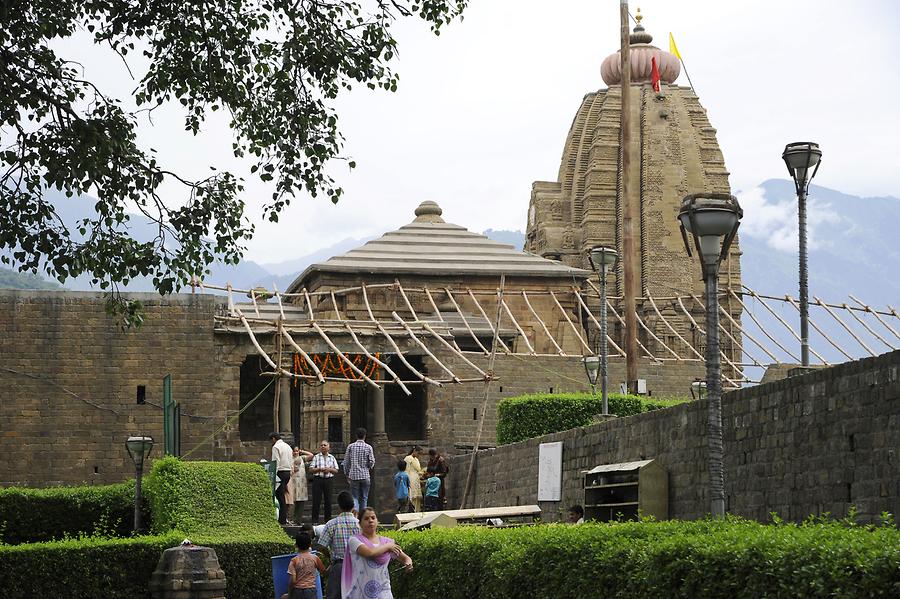Shiva Temple of Baijnath#

Shiva Temple of Baijnath, July 2011, © Gerhard Huber, under CC BY-NC 4.0 +Edu
Mit seinen 1200 Jahren gilt der Shiva-Tempel von Bajinath als ältestes diesem Gott geweihte Heiligtum Indiens. Der Hinduismus, vor 3500 Jahren von den Ariern ins Land gebracht, kennt weder Gründer, noch Propheten, noch eine oberste Autorität, noch eine heilige Schrift, dafür aber ein schier unüberschaubares Nebeneinander unzähliger Lehrbücher und hunderttausender Götter. Er ist nicht nur Religion allein, sondern vielmehr ein komplexer Organismus aus Sekten, Kulten, und Ritualen, der Philosophie, Religion und soziale Normen vereint und damit das Leben eines Hindu von der Wiege bis zur Bahre bestimmt. Zum Hindu wird man ausschließlich durch Geburt, weshalb Konvertierung und Missionierung keine Bedeutung haben.
Dennoch lassen sich einige, für alle Hindus verbindliche Grundsätze aufstellen. Als unumstößliche Wahrheit gilt die Existenz einer vereinigenden Urkraft, die Weltenseele Brahman, die einen ewigen Kreislauf aus Schöpfung und Zerstörung bewirkt. Die Menschen sind in diesem Kreislauf aus Leben, Tod und Wiedergeburt gefangen. Doch gibt es hier so wie im Buddhismus die Möglichkeit, diesem Zyklus zu entkommen und seine individuelle Seele mit der Weltenseele brahman zu vereinen, was einer endgültigen Erlösung gleichkommt. Um dieses höchste Ziel zu erreichen, bedarf es jedoch unzähliger Leben, um möglichst viel gutes Karma zu sammeln. Karma bezeichnet die Summe aller Taten eines Lebens. Wer besser im Sinne der moralisch-sittlichen Ordnung lebt, darf auf eine höhere Wiedergeburt hoffen. Eng damit verknüpft ist das Kastenwesen, das jedem Menschen gemäß seinem Karma eine feste Position in der sozialen Hierarchie zuordnet. Unmut gibt es keinen, denn dem Glauben nach ist jeder für sein persönliches Karma selbst verantwortlich. Bei Fehlverhalten droht gar eine Wiedergeburt als Pflanze oder Tier. So liest man im Gesetzbuch des Manu: 'Wenn man Korn stiehlt, wird man eine Ratte, bei Honig eine Mücke, bei Milch eine Krähe und bei Süßigkeiten ein Hund.'
Niemals kann es jedoch schaden, die Götter um Beistand zu bitten. Immerhin hat der Hinduismus mehr als 330.000 davon im Angebot. Der Pantheon ist kaum zu durchschauen, treten doch die verschiedenen Götter in zahllosen Erscheinungsformen und Inkarnationen auf, die wiederum als eigenständige Gottheiten verehrt werden. Zu den höchsten zählen Brahma, Vishnu und Shiva, die für die drei Prinzipien Schöpfung, Erhaltung und Zerstörung stehen, symbolisiert durch die magische Silbe AOM, A für Einatmen-Schöpfung, O für Atem halten und M für Ausatmen-Zerstörung. Kompliziert wird es bereits hier, denn Shiva, Indiens beliebtester Gott, steht zugleich für Zerstörung und Erneuerung. Er tritt der indischen Mythologie zufolge in nicht weniger als 1008 Erscheinungsformen und unter ebenso vielen Namen auf. Große Verehrung genießen auch die Gattinnen und Reittiere des Göttertriumvirats. Auf der Beliebtheitsskala ganz oben steht der Sohn Shivas, der elefantenköpfige Ganesha, der seinen Verehrern Glück, Reichtum und Intelligenz bringt.
1200 years old, the Shiva Temple of Bajinath is the oldest sanctuary dedicated to this god in India. Hinduism, introduced by the Aryans 3500 years ago, knows neither founders, nor prophets, nor a supreme authority, nor a holy scripture, but a seemingly unmanageable coexistence of countless textbooks and hundreds of thousands of gods. It is not just religion alone, but rather a complex organism of sects, cults, and rituals that unites philosophy, religion, and social norms, determining the life of a Hindu from cradle to grave. You become a Hindu exclusively through birth, which is why conversion and proselytizing have no meaning.
Nevertheless, there are some principles that are binding on all Hindus. The incontestable truth is the existence of a unifying primal force, the world soul Brahman, which causes an eternal cycle of creation and destruction. People are trapped in this cycle of life, death, and rebirth. But here, as in Buddhism, there is the possibility of escaping this cycle and uniting one's individual soul with the world soul brahman, which amounts to final salvation. To reach this highest goal, however, it takes countless lives to collect as much good karma as possible. Karma is the sum of all the deeds of a life. Those who live better in the sense of the moral-ethical order may hope for a higher rebirth. Closely related to this is the caste system, which assigns every person according to his karma a fixed position in the social hierarchy. There is no displeasure, because according to the belief everyone is responsible for his personal karma. Misconduct threatens even a rebirth as a plant or animal. So you read in the Manu Code: 'If you steal grain, you become a rat, honey a mosquito, milk a crow, and sweets a dog.'
But it can never hurt to ask the gods for help. After all, Hinduism has more than 330,000 of them to offer. The pantheon is hard to see through, as the various gods appear in countless manifestations and incarnations, which in turn are worshiped as separate deities. Among the highest are Brahma, Vishnu, and Shiva, who stand for the three principles of creation, preservation, and destruction, symbolized by the magic syllables AOM, A for inhalation creation, O for breath, and M for exhalation destruction. It is already complicated here, because Shiva, India's most popular god, stands for destruction and renewal. According to Indian mythology, it appears in as many as 1008 manifestations and as many names. Great reverence is also enjoyed by the wives and mounts of the gods-triumvirate. On top of the popularity scale, the son of Shiva stands, the elephant-headed Ganesha, who brings luck, wealth and intelligence to his admirers.